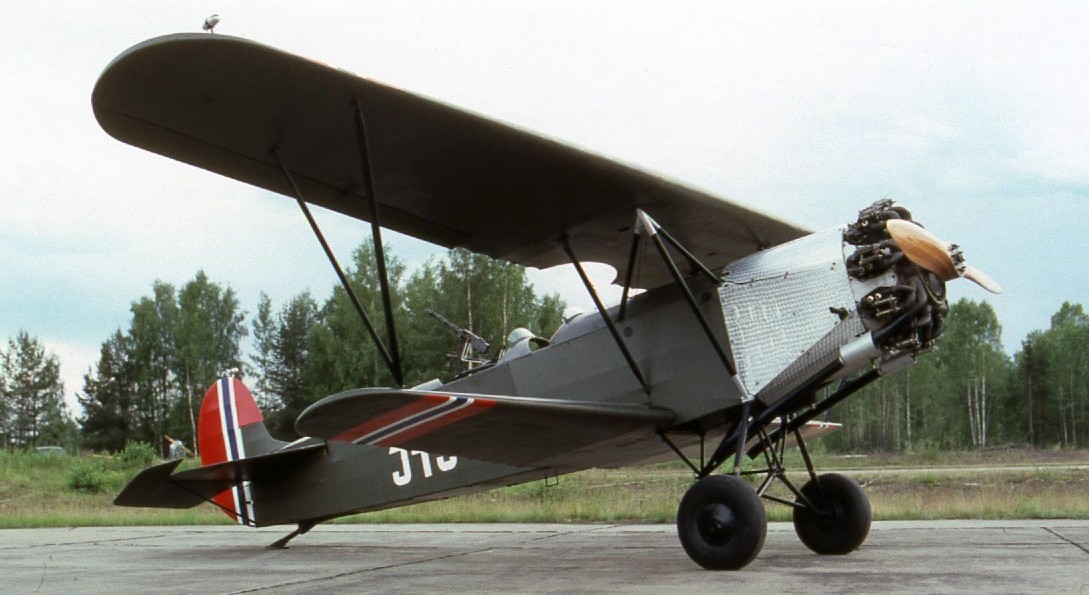Suomen ilmavoimat hankkivat erään tiedon mukaan sekä D- että E-version koneita: ensin yksi E-versio vuonna 1927 ja vuonna 1934 13 E-versiota lisää.
Ruotsi lahjoitti talvisodan aikana kolme E-versiota ja kesäkuussa 1940 Norjasta lennettiin kaksi E-versiota Suomeen. Koneet toimivat tiedustelukoneina.
Koneen D- ja E-versiot olivat suosituimmat. Kone oli käytössä Bolivian, Ruotsin, Suomen, Tanskan, Sveitsin, Japanin, Neuvostoliiton, Unkarin, Norjan, Italian ja Alankomaiden ilmavoimissa 1926–1940. Koneet valmistettiin yleensä lisenssillä ko. maissa.
Hollanti ja Norja käyttivät tällaisia koneita Saksan hyökkäystä vastaan vuonna 1940. Saksa siirsi myöhemmin ko. sotasaaliskoneet Luftwaffen yöpommituskäyttöön itärintamalle, jossa esimerkiksi virolaiset lentäjät käyttivät entisiä tanskalaisia koneita.
Sveitsi käytti koneitaan maalihinauskoneina vuoteen 1954 asti.
Ruotsin ilmavoimat hankki koneita vuonna 1927 hävittäjiksi (J3 tunnus Ruotsissa) ja tiedustelukoneiksi (S3). Tavoitteena oli lisenssivalmistus Ruotsissa.
Hävittäjäkoneeksi C.V:stä ei kuitenkaan ollut.
Yleiset ominaisuudet
Kärkiväli: 12,5 m D-versio (C.V-E 15,3 m)
Pituus: 9,5 m
Korkeus: 3,5 m
Siipipinta-ala: 46,1 m²
Miehistö:: 2
Tyhjäpaino: 1 420 kg
Suurin lentoonlähtöpaino: 2 270 kg
Voimalaite: Bristol Jupiter VI, 450 hv, Hispano-Suiza, 450 hv, Rolls Royce-Kestrel XI, 520 hv, jopa 970 hv moottoreita käytetty.
C.V-E: 1 kpl - Bristol Jupiter moottorin FO-39
C.V-E: 13 kpl - Pegasus moottorin FO-65--77
CV-E: 3 kpl - Mercury moottori, lahja Ruotsista, FO-19, -23 ja -80 (talvisota)
CV-D: 2 kpl - Panther moottori, internoitiin Norja ilmavoimat, FO-65 & -66 (Lentäjät toivat koneet pois saksan miehitykseltä)
Huippunopeus: 230 km/h
Lentomatka: 770 km
Lakikorkeus: 7 000 m
Aseistus: 2 kpl 7,9 mm konekivääriä, takaa ampujalla yksi 7,9 mm konekivääri sekä 200 kg pommeja.

------------------------------------------------------------------------
Fokker C.V was a Dutch light reconnaissance and bomber biplane aircraft manufactured by Fokker. It was designed by Anthony Fokker and the series manufacture began in 1924 at Fokker in Amsterdam.
The Finnish Air Force used both C.V-Ds and C.V-Es. One C.V-E was purchased in 1927, with delivery 20 September, and a further 13 were purchased on 17 March 1934, arriving in the winter of 1935. During the Winter War, Sweden donated three more C.V-Es. Two C.V-Ds were also flown from Norway to Finland at the closing stages of the Norwegian Campaign.
These were interned and turned over to the FAF. The aircraft were used as reconnaissance and light bomber aircraft between 20 September 1927 and 14 February 1945. During the Winter War, the Finnish C.Vs flew 151 reconnaissance and harassment bombing sorties without suffering any losses. The Continuation War saw the C.Vs flying an unknown number of sorties and suffering one aircraft loss.

The C.V was constructed in the early 1920s by Anthony Fokker. The aircraft was intended as a twin-seated reconnaissance and bomber aircraft. When shown to the public in 1924 was manufactured in a variety of versions; the customer could choose from five different wing constructions (which varied in wing span). The radial engines could give between 336-723 kW (450-970 hp). The landing gear could be changed from wheels to pontoons.

The aircraft became an export success for Fokker, it was sold and/or license manufactured in Bolivia, China, Denmark, Finland, Hungary, Italy, Japan, the Netherlands, Norway, Switzerland, the Soviet Union and the US.[1] Sweden purchased two different versions to use as models for their license manufacturing of the reconnaissance version S 6 and a fighter version J 3.
The Dutch Air Force used the C.V in front line service against the German Luftwaffe during World War II. After the Dutch surrender, the aircraft were taken over by Luftwaffe and used on the Eastern front until 1944.
General characteristics
Crew: 2
Length: 9.25 m (30 ft 4 in)
C.V-D: 9.4 m (31 ft)
C.V-E: 9.53 m (31 ft)
Wingspan: 12.50 m (41 ft 0 in)
C.V-E: 15.3 m (50 ft)
Height: 3.3 m (10 ft 10 in)
Wing area: 39.3 m2 (423 sq ft)
Empty weight: 1,920 kg (4,233 lb)
Max takeoff weight: 2,145 kg (4,729 lb)
C.V-D: 2,000 kg (4,409 lb)
C.V-E: 2,400 kg (5,291 lb)
Powerplant: 1 × Rolls Royce Kestrel VIIb V-12 liquid-cooled piston engine, 470 kW (630 hp)
C.V-D: 1 x Bristol Jupiter 336 kW (451 hp) 9-cyl. air-cooled radial piston engine
C.V-E: 1 x Napier Lion 298 kW (400 hp) W-12-cyl. water-cooled piston engine
or 1 x Armstrong Siddeley Panther II 429 kW (575 hp) 14-cyl. air-cooled radial piston engine
or 1 x Bristol Jupiter VI 313 kW (420 hp) 9-cyl. air-cooled radial piston engine
Performance
Maximum speed: 250 km/h (155 mph; 135 kn)
C.V-D: 215 km/h (134 mph)
C.V-E: 215 km/h (134 mph)
Cruising speed: 180 km/h (112 mph; 97 kn)
Range: 1,000 km (621 mi; 540 nmi)
Service ceiling: 6,500 m (21,325 ft)
C.V-D: 5,900 m (19,357 ft)
Armament
Guns:
2 × 7.9 mm (.31 in) FN synchronized fixed machine guns
1 × 7.9 mm (.31 in) Lewis machine gun on flexible mount in the rear
C.V-D: 2 × 7.2 mm (.28 in) machine guns
C.V-E: 1 × 7.9 mm (.31 in) machine gun
Bombs: 200 kg (440 lb) of bombs under wings
C.V-D: 16 × 8 kg (17½ lb) bombs or 4 × 50 kg (110 lb) bombs
C.V-E: 16 × 8 kg (17½ lb) bombs or 4 × 50 kg (110 lb)bombs

Ei kommentteja:
Lähetä kommentti
Kaikenlaiset kommentit ovat tervetulleita.